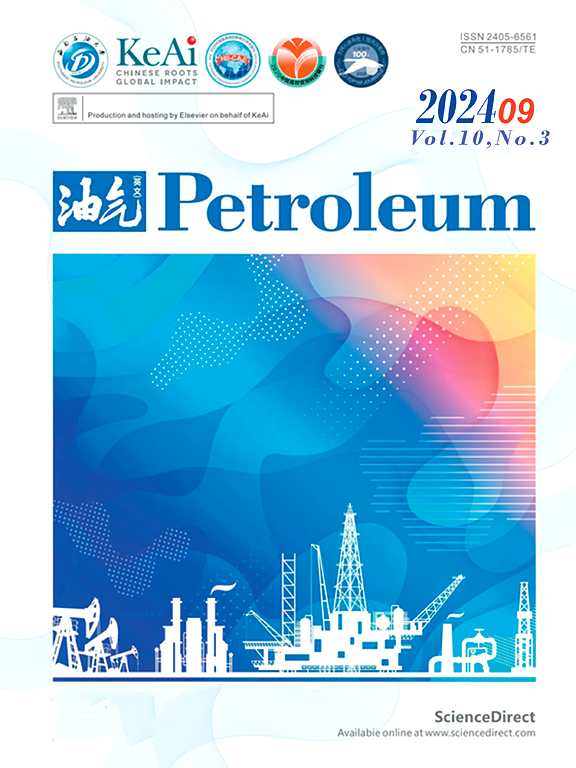致密油藏压裂阶段和簇参数的智能优化
IF 4.2
Q2 ENERGY & FUELS
引用次数: 0
摘要
新疆准噶尔盆地马湖油田储层质量差、水平应力差大、非均质性强,水力裂缝几何形状不清晰、井/段间压裂效果差异大、段/段设计自动化程度不高,给采油带来了挑战。针对上述问题,提出了马131井区致密砾岩油藏阶段参数和簇参数的系统智能设计。首先,通过敏感性分析,确定了划分阶段的关键参数(储存系数、脆性指数和最小水平主应力),并基于这些关键参数的相似性提出了分段算法;为了快速计算出不同压裂簇的产能,采用缝采一体化数值模拟方法,建立了单簇产量预测数据集。基于压裂段划分结果,利用上述数据集快速优化簇间距和注入量,并以平衡裂缝起裂和扩展为目标优化簇位置。最后,从测井资料出发,实现了压裂段和压裂簇的自动设计。将该优化方法应用于一口实际井中,取得了增产增效的效果。该方法能够在考虑裂缝扩展、产能和经济效益的基础上,高效、智能地对水平井分段和压裂簇进行优化设计,为致密砾岩油藏等非常规油藏的压裂设计提供理论和方法支持。本文章由计算机程序翻译,如有差异,请以英文原文为准。

Intelligent optimization of fracturing stage and cluster parameters for tight oil reservoir
The Mahu oilfield in the Junggar Basin of Xinjiang has the characteristics of poor reservoir quality, large horizontal stress difference, and strong heterogeneity, which poses challenges in oil production due to the unclear hydraulic fracture geometry, large fracturing effectiveness difference among wells/stages, and the lack of automation in stage and cluster designs. To address the above issues, this study proposes systematically intelligent designs for stage and cluster parameters in the tight conglomerate oil reservoir in the Ma131 well area. First, through sensitivity analysis, the key parameters for stage division (storage coefficient, brittleness index, and minimum horizontal principal stress) are identified, and a stage division algorithm is developed based on the similarity of these key parameters. In order to quickly calculate the productivity of different cluster designs, a single cluster production prediction dataset was established by using the fracturing-production integrated numerical simulation method. Based on the results of fracturing stage division, cluster spacing and injection volume are quickly optimized using the above dataset, and the cluster locations are optimized with the objective of balanced fracture initiation and propagation. Finally, the automatic designs of fracturing stage and cluster starting from the well logging data is realized. Then, the proposed optimization method is applied to a practical well and both the production and profit are increased with the optimized designs. The proposed method can efficiently and intelligently optimize the stage and cluster designs for horizontal wells with the consideration of fracture propagation, productivity, and economic benefits, which helps provide theoretical and methodological support for fracturing designs in unconventional reservoirs such as the tight conglomerate oil reservoirs in this work.
求助全文
通过发布文献求助,成功后即可免费获取论文全文。
去求助
来源期刊

Petroleum
Earth and Planetary Sciences-Geology
CiteScore
9.20
自引率
0.00%
发文量
76
审稿时长
124 days
期刊介绍:
Examples of appropriate topical areas that will be considered include the following: 1.comprehensive research on oil and gas reservoir (reservoir geology): -geological basis of oil and gas reservoirs -reservoir geochemistry -reservoir formation mechanism -reservoir identification methods and techniques 2.kinetics of oil and gas basins and analyses of potential oil and gas resources: -fine description factors of hydrocarbon accumulation -mechanism analysis on recovery and dynamic accumulation process -relationship between accumulation factors and the accumulation process -analysis of oil and gas potential resource 3.theories and methods for complex reservoir geophysical prospecting: -geophysical basis of deep geologic structures and background of hydrocarbon occurrence -geophysical prediction of deep and complex reservoirs -physical test analyses and numerical simulations of reservoir rocks -anisotropic medium seismic imaging theory and new technology for multiwave seismic exploration -o theories and methods for reservoir fluid geophysical identification and prediction 4.theories, methods, technology, and design for complex reservoir development: -reservoir percolation theory and application technology -field development theories and methods -theory and technology for enhancing recovery efficiency 5.working liquid for oil and gas wells and reservoir protection technology: -working chemicals and mechanics for oil and gas wells -reservoir protection technology 6.new techniques and technologies for oil and gas drilling and production: -under-balanced drilling/gas drilling -special-track well drilling -cementing and completion of oil and gas wells -engineering safety applications for oil and gas wells -new technology of fracture acidizing
 求助内容:
求助内容: 应助结果提醒方式:
应助结果提醒方式:


